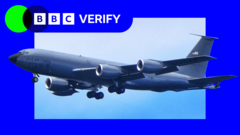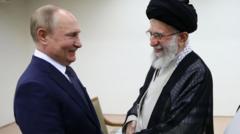Are US Jets on the Move Amid Rising Iran Attack Fears?

### Understanding the Recent Movement of U.S. Military Aircraft: Implications and Analysis
In the past few days, a notable surge in U.S. military aircraft movements has raised eyebrows and sparked discussions about potential military interventions and geopolitical strategies. Tracking data has revealed that over 30 U.S. military planes, primarily tanker aircraft, have been relocated from bases in America to various locations in Europe. This article delves into the implications of these movements, the strategic considerations behind them, and what they may signal for ongoing conflicts, particularly regarding Iran and Israel.
#### The Current Context of Military Movements
The recent aircraft movements come amidst escalating tensions between Israel and Iran. The exchange of strikes has intensified, particularly with Israel launching operations targeting Iran's nuclear capabilities. As the geopolitical landscape shifts, the presence of U.S. military assets in Europe raises questions about America's role in potential conflicts and its support for allies.
##### Key Aircraft Involved
The primary aircraft involved in this movement are the KC-135 tanker planes. They play a crucial role in refueling fighter jets and bombers, enabling extended operational capabilities.
**Key details include:**
- **Aircraft Type:** KC-135 Tankers
- **Recent Destinations:** Spain, Scotland, and England
- **Operational Role:** Aerial refueling for combat aircraft
These aircraft were tracked flying east of Sicily, with some landing in Crete, indicating a strategic positioning that could be preparatory for future operations.
#### Expert Opinions on Military Strategies
Military analysts have weighed in on the significance of these movements. Justin Bronk, a senior analyst at the Royal United Services Institute, described the deployments as "highly suggestive" of U.S. contingency plans aimed at supporting intensive combat operations in the region. This statement highlights the possibility that the U.S. is gearing up for a more active role in the Middle East.
Vice-Admiral Mark Mellett, former head of the Irish Defence Forces, suggests that these movements could be a part of a broader policy of "strategic ambiguity." This approach may serve to influence Iran's negotiations over its nuclear program by demonstrating military readiness without direct engagement.
##### The Role of Aircraft Carriers
In addition to the tanker aircraft, the U.S. has moved the USS Nimitz, an aircraft carrier, from the South China Sea toward the Middle East. This repositioning indicates a flexible military posture and the ability to respond rapidly to emerging threats.
**Key points about the USS Nimitz:**
- **Type:** Aircraft Carrier
- **Capabilities:** Hosts fighter jets and is accompanied by guided missile destroyers
- **Current Status:** Heading towards the Middle East after a planned event was canceled
The significance of the USS Nimitz’s movements cannot be overstated, as it provides the U.S. military with a powerful platform for air operations in the region.
#### The Potential for Military Action Against Iran
The backdrop of these military movements is the ongoing tension surrounding Iran's nuclear program. Reports indicate that Iran operates two principal underground enrichment sites, Natanz and Fordo, which have been targeted in the past. The U.S. would likely need to employ advanced munitions, such as the GBU-57A/B Massive Ordnance Penetrator, to penetrate these facilities effectively.
**Key considerations include:**
- **Target Facilities:** Natanz and Fordo
- **Required Munitions:** GBU-57A/B, known as "bunker busters"
- **Delivery Systems:** B-2 stealth bombers, capable of carrying these munitions
The strategic positioning of B-2 bombers at Diego Garcia, despite their recent absence, underscores the U.S. military's capability to launch strikes if necessary. Analysts suggest that even if the bombers are not currently stationed at Diego Garcia, they can operate from the continental U.S. to engage Iranian targets.
#### Implications for U.S.-Iran Relations
The military movements and potential for intervention signal a critical juncture in U.S.-Iran relations. With the U.S. demonstrating its military readiness, the pressure on Iran to comply with nuclear negotiations may increase. However, this strategy carries risks, including the potential for escalation into broader conflict.
**Factors to consider:**
- **Iran's Response:** How Iran perceives and reacts to U.S. military positioning.
- **Diplomatic Efforts:** The impact of military readiness on ongoing negotiations regarding Iran's nuclear program.
- **Regional Stability:** The broader implications for stability in the Middle East and U.S. relations with allies.
#### Conclusion
The recent movements of U.S. military aircraft and naval assets reflect a complex interplay of strategy, diplomacy, and military readiness amid rising tensions with Iran. While these actions may serve as a deterrent and a signal of support for allies like Israel, they also raise questions about the potential for conflict and the U.S.'s role in the region.
As the situation evolves, it remains crucial to monitor these developments closely. The balance between military preparedness and diplomatic negotiations will play a pivotal role in shaping the future of U.S.-Iran relations and broader Middle Eastern dynamics.
What are your thoughts on the potential outcomes of these military movements? How do you think they will impact the ongoing conflict in the Middle East?
### FAQs
#### What types of military aircraft have been moved recently?
The recent movements primarily involve KC-135 tanker aircraft, which are crucial for refueling fighter jets and bombers during operations.
#### How does the USS Nimitz fit into the current military strategy?
The USS Nimitz serves as a powerful platform for air operations and enhances the U.S. military's ability to respond quickly to emerging threats in the Middle East.
#### What are the implications of the U.S. military's readiness regarding Iran's nuclear program?
The military readiness could pressure Iran to engage more seriously in negotiations over its nuclear program, but it also raises the risk of escalation into conflict.
#### How could U.S. military operations affect regional stability?
Increased military presence and potential action could lead to heightened tensions in the region, impacting relationships with allies and adversaries alike.
### Engage with the Topic
As the situation unfolds, the implications of these military movements will be closely watched. How do you foresee the balance of power shifting in the Middle East?
#MilitaryStrategy #USIranRelations #MiddleEastConflict
Published: 2025-06-17 19:09:13 | Category: technology



